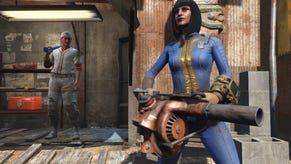Oh, So That's Nintendo's Next Move
Nintendo's price cuts and new hardware announcements offer some surprises, but certainly nothing out of character.
This article first appeared on USgamer, a partner publication of VG247. Some content, such as this article, has been migrated to VG247 for posterity after USgamer's closure - but it has not been edited or further vetted by the VG247 team.
Recently, I took a long, hard look at Nintendo's current situation regarding the Wii U's struggles and wondered, "What's Nintendo's next move?" Today, they've answered that question by announcing Wii U bundles, a partial price drop for the Wii U, and a low-cost, feature-reduced 3DS variant called the 2DS.
While the company's response proves some of my assumptions or conclusions to be completely off-base -- especially my hunch about the unlikeliness of Wii U price drops -- on the whole their general strategy revolves around their long-time core strength and strategic fulcrum: The portable market. With the 2DS, Nintendo is redoubling their efforts around a cheap handheld systems backed by appealing software, aimed directly at kids... which, as I noted, has historically been Nintendo's winning play.
But first, let's talk about the Wii U price cut. While I suggested a price cut on the console could be potentially fatal to the company given the fact that it was already being sold at a loss (something Nintendo, historically speaking, diligently avoids), I didn't take into account the bizarre half-measure they've implemented. Yes, the Wii U deluxe set and bundle are being slashed from $349 to $299, but the basic set remains fixed at $299. So all Wii U systems are $299 now, even the one without bells or whistles.

Unusual as this decision seems at first glance, it makes a lot of sense. Nintendo clearly intends to phase out the standard set and simply replace it with deluxe bundles. The reasoning behind this approach was recently laid out in a NeoGAF post that appeared a couple of days before Nintendo began to roll out info on the price cut to the press and managed to be so precisely on-point that I suspect it was based on some sort of insider info.
In short, though, the Wii U loses money for Nintendo with each unit it sells. However, the cost of the extras included with Wii U's deluxe bundles is, from a production and materials standpoint, essentially negligible. 32GB of flash memory costs almost nothing, and with the Wind Waker set marking a bundle strategy transition to preinstalled digital content (similar to existing 3DS bundles), even the modest extra cost of an included packaged game goes away; Nintendo wouldn't confirm that the standard Deluxe set's Nintendo Land pack-in would go digital as well, but it seems likely. Nintendo does spend money to develop games, but those are sunk costs; in terms of manufacturing expenses, the difference between the basic and deluxe Wii U models is incredibly slim. Dropping the bundle price but not the baseline console price allows Nintendo to offer a better deal for consumers without taking a severe hit to the bottom line. In bookkeeping terms, it's not so much that they're reducing the price of the Wii U hardware as throwing in all the extras for free.
But doesn't this make the basic Wii U package completely pointless? Absolutely, and while Nintendo wouldn't say it outright, it's obvious the white system has reached the end of its life. Nintendo's Scott Moffitt admitted that supplies of the basic set have sold through very well, with the implication that what's available at retail now is probably all that will be made. Going forward, it seems pretty likely Nintendo will push $299 Wii U bundles exclusively, which should make the system considerably more attractive. Much like the console itself, its price sits between those of the current- and next-generation competition.
However, Nintendo isn't implementing some sort of radical bonus for early Wii U adopters as they did with the 3DS ambassador program. Unsurprisingly, the Wii U strategy for now seems to be to stay the course; between a few high-profile titles (including Mario and Zelda) and the price cut, Nintendo is clearly content to weather the 2013 holiday season and the launch of two rivals systems before taking stock and making more radical adjustments to its plan, if necessary.

In the meantime, the company's R&D efforts have clearly focused on making Nintendo's handheld lineup as profitable as possible. The 2DS takes aim at cornering the portable market on value by taking the 3DS, making major (and yet, ultimately, superficial) cuts to its functionality, and greatly streamlining the physical design of the machine. At $129, it doesn't quite hit the all-important sub-$100 price point, but it should still be far more attractive to budget-conscious parents than the basic 3DS model ($169) or the 3DS XL ($199), which now costs the same as a PlayStation Vita. How well it can fare against the greater mobile market remains to be seen -- certainly the hardware seems like a great value compared to gaming tablets, but (anecdotally speaking) I've found Nintendo's refusal to race to the bottom for software pricing still gives many parents pause.
Curiously, the 2DS is even more of a tablet-style system than it appears at first glance, as it actually features a single large screen in its center, not two separate ones. As one of their cost-cutting design measures, Nintendo reduced the number of screens in the system from two to one, and the appearance of separate screens is merely simulated by the way the case masks out the extraneous portions. This means the entire screen is by necessity a touchscreen, with the upper screen protected by a layer of plastic that sits above it. While this makes no difference for the system's normal functions -- after all, neither the system's firmware or its software would recognize the hidden, inactive zones of the screen or the upper portion's touch capabilities, even if you exposed those portions -- I'm curious to see what hardware modders manage to do with the system.
What I find particularly interesting about the 2DS is that Nintendo has evidently developed it primarily with Western markets in mind. The system isn't on the horizon for the Japanese market, and while I'm sure it will eventually make it way into Nintendo's home territory, it won't happen for the foreseeable future. Frankly, it doesn't need to; according to Nintendo's most recent quarterly earnings report, the 3DS sold 640,000 units in Japan this spring versus 360,000 in the U.S. -- in other words, it performed nearly twice as well in a market roughly half the size. The 3DS continues to dominate Japan, meaning there's not much call for Nintendo to sweeten the pot. But the U.S. market continues to lag, and Nintendo knows the market well enough to know to pander to the fundamental frugality of Americans. Launching the 2DS alongside Pokémon X & Y Versions in particular is smart marketing.

Despite 2DS's target market being kids, I do think the device has potential to appeal to more hardcore fans as well. It's much more comfortable to hold, for starters. Also, it's a much less expensive means to acquire a foreign system for access to software blocked off by region-locking, and I don't doubt that whenever the system finally shows up in Japan we'll see plenty of U.S. and European gamers importing one for themselves.
Ultimately, though, Nintendo's next move isn't too far removed from what many of us -- myself included -- expected. A modest attempt to position Wii U as a better value without actually breaking the bank, and a redoubled attempt to wring every last penny out of the ever-profitable portable market: It's classic Nintendo, through and through. These tactics seem more like a temporary band-aid than a long-term solution, but at the very least they should help see the company through a potentially tempestuous holiday season and give them time to regroup.
Of course, now we have to wonder: What's Nintendo's next move after this? The cycle never ends.
For more on today's Nintendo announcements, see the news breakdown and our interview with Scott Moffitt on GamesIndustry.








